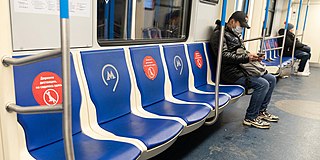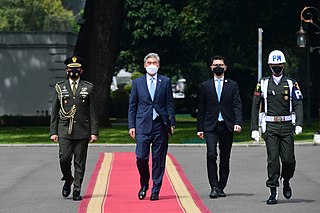Related Research Articles
The Rail Delivery Group Limited (RDG), previously the Association of Train Operating Companies, is the British rail industry membership body that brings together passenger and freight rail companies, Network Rail and High Speed 2. The RDG is approximately half-funded by Network Rail, the remainder of its funding being provided by the various transport groups it represents.

Manchester Metrolink is a tram/light rail system in Greater Manchester, England. The network has 99 stops along 64 miles (103 km) of standard-gauge route, making it the most extensive light rail system in the United Kingdom. Metrolink is owned by the public body Transport for Greater Manchester (TfGM) and operated and maintained under contract by a Keolis/Amey consortium. Over the 2022/23 financial year 36 million passenger journeys were made on the system.

The Tyne and Wear Metro is an overground and underground light rail rapid transit system serving Newcastle upon Tyne, Gateshead, North Tyneside, South Tyneside, and the City of Sunderland. The network opened in stages from August 1980 and now serves a total of 60 stations, with two lines covering 77.5 km (48.2 mi) of track. The Metro can be accessed from a mixture of underground and above-ground stations. It has been described as the "first modern light rail system in the United Kingdom". The system is currently owned and operated by the Tyne and Wear Passenger Transport Executive, thus is fully under public ownership and operation.

The Atchison, Topeka and Santa Fe Railway, often referred to as the Santa Fe or AT&SF, was one of the largest Class 1 railroads in the United States.

Leggings are several types of leg attire that have varied through the years. Modern usage from the 1960s onwards has come to refer to elastic close-fitting high-rise garments worn over the legs typically by women, such as leg warmers or tights. Usage from the 18th century refers to men's wear usually made of cloth or leather that is wrapped around the leg down to the ankle. In the 19th century, leggings usually referred to infants' leg clothing that were matched with a jacket, as well as leg-wrappings made of leather or wool and worn by soldiers and trappers. Leggings prominently returned to women's fashion in the 1960s, drawing from the form-fitting clothing of dancers. With the widespread adoption of the synthetic fibre Lycra and the rise in popularity of aerobics, leggings came to further prominence in the 1970s and 1980s, and eventually made their way into streetwear. Leggings are a part of the late 2010s into the 2020s athleisure fashion trend of wearing activewear outside sporting activities and in casual settings.

Arlanda Express is an airport rail link connecting Stockholm Central Station with the Stockholm Arlanda Airport outside Stockholm, Sweden. Operated by A-Train AB, the trip takes 18 minutes and runs three to six times per hour using seven X3 electric multiple units. The services operate over the East Coast and Arlanda Lines calling at Stockholm Central, Arlanda North and Arlanda South stations. The service was used by 2.7 million passengers in 2007 and by 3.3 million passengers in 2012.

Invisible disabilities, also known as hidden disabilities or non-visible disabilities (NVDs), are disabilities that are not immediately apparent. They are typically chronic illnesses and conditions that significantly impair normal activities of daily living.

England has a dense, multimodal transportation infrastructure. The Department for Transport is the government department responsible for the transport network in England. The Secretary of State for Transport is the member of the cabinet responsible to Parliament for the Department for Transport.
Sunflower is the common sunflower, a species of annual flowering plant first domesticated in the Americas.

Thirsk railway station is on the East Coast Main Line and serves the town of Thirsk, North Yorkshire, England. It is 210 miles 56 chains (339.1 km) down the line from London King's Cross and is situated between York to the south and Northallerton to the north. Its three-letter station code is THI.

Sunderland is a railway and metro station in Sunderland, Tyne and Wear, England. It is on the Durham Coast Line, which runs between Middlesbrough and Newcastle, via Hartlepool. It is owned by Network Rail and managed by Northern Trains. Since 31 March 2002, the station has also been served by the Tyne and Wear Metro's Green Line.

Bishop Auckland is a railway station that serves the market town of Bishop Auckland in County Durham, North East England, 11 miles 77 chains (19.3 km) north-west of Darlington. The station is the Western terminus of the Tees Valley Line, which links it to Saltburn via Darlington. It is owned by Network Rail and managed by Northern Trains.

The Tyne and Wear Metrocars are a fleet of light rail vehicles manufactured by Metro-Cammell for the Tyne and Wear Metro in North East England between 1978 and 1981. For operation on Network Rail controlled tracks between Pelaw Junction and Sunderland, they are designated on TOPS as the Class 599. Most were refurbished between 2010 and 2015 by Wabtec Rail at Doncaster Works and are scheduled to be replaced by Class 555 rolling stock from 2024.

Iowa Pacific Holdings was a holding company that owned railroad properties across North America and the United Kingdom, as well as providing services such as railcar repairs, leasing, management and consulting services to other operators. The company was founded in 2001 with headquarters in Chicago, Illinois.

The European Union Persons with Reduced Mobility (PRM) legislation is intended to ensure that Persons with Reduced Mobility (whether disabled, elderly or otherwise) traveling via public transport, whether by air, land or sea, should have equal access to travel as compared to travelers with unrestricted mobility. Travel providers are compelled to provide and install sufficient access facilities to enable Passenger with Reduced Mobility to enjoy similar access to other passengers (where feasible and with certain safety exemptions).

The COVID-19 pandemic had a large impact on public transport. Many countries advised that public transport should only be used when essential; passenger numbers fell drastically, and services were reduced. Provision of a reasonable service for the much smaller number of fare-paying passengers incurred large financial losses.

During the COVID-19 pandemic, face masks or coverings, including N95, FFP2, surgical, and cloth masks, have been employed as public and personal health control measures against the spread of SARS-CoV-2, the virus that causes COVID-19.

The wearing of non-medical face masks in public to lessen the transmission of COVID-19 in the United States was first recommended by the CDC on April 3, 2020, as supplemental to hygiene and appropriate social distancing. Throughout the pandemic, various states, counties, and municipalities have issued health orders requiring the wearing of non-medical face coverings — such as cloth masks — in spaces and businesses accessible to the public, especially when physical distancing is not possible.

The Health Protection (England) Regulations 2020 is a statutory instrument (SI) brought into force on 15 June 2020 by the Secretary of State for Transport, Grant Shapps, in response to the COVID-19 pandemic. The regulations required the wearing of a face covering when travelling on public transport such as trains, buses and aircraft in England, later extended to include taxis and private hire vehicles. The regulations were revoked on 18 July 2021.

The Health Protection (England) Regulations 2020 is a statutory instrument (SI) brought into force on 23 July 2020 by the Secretary of State for Health and Social Care, Matt Hancock, in response to the COVID-19 pandemic. Subject to some exceptions, it required members of the public in England to wear a face covering in most indoor shops, shopping centres, banks, post offices and public transport hubs. The regulations were similar to the Health Protection (England) Regulations 2020, which were brought into force on 15 June 2020. The regulations were revoked on 18 July 2021, five days before they would otherwise have expired.
References
- ↑ O'Donoghue, Sarinah (2021-04-08). "Sunflower lanyards - what are they for?". BBC The Social. Retrieved 2021-06-28.
- ↑ "All of Britain's rail companies to adopt Sunflower lanyard scheme". Rail Technology Magazine. 2020-07-28. Retrieved 2021-06-28.
- ↑ "Hidden Disabilities Sunflower Lanyard Program Adopted at Tulsa International Airport". Aviation Pros. 2020-12-16. Retrieved 2021-06-28.
- ↑ Skaggs, Robyn Gautschy (2021-06-18). "Central Illinois Regional Airport has a new way to help people with hidden disabilities". The Pantagraph. Retrieved 2021-06-28.
- ↑ "Beware of the Sunflower counterfeits". Hidden Disabilities Sunflower. 2021-01-26. Retrieved 2021-06-28.
- ↑ "Hidden disabilities lanyard scheme launched at Guernsey Airport". ITV. 2017-12-02. Retrieved 2021-06-28.
- ↑ Evans, Paul (2021-01-25). "Concerns over misuse of hidden disabilities 'sunflower lanyard'". Tenby Observer. Archived from the original on 2022-10-12. Retrieved 2021-06-28.